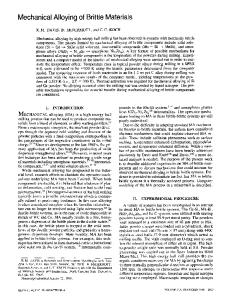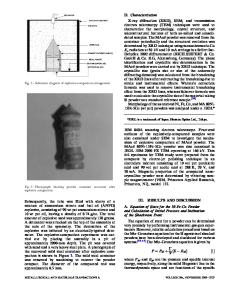Mechanical alloying of nb-al powders
- PDF / 808,360 Bytes
- 8 Pages / 597.28 x 777.28 pts Page_size
- 109 Downloads / 384 Views
I.
INTRODUCTION
THE Nb-A1 alloys with their high melting points and excellent oxidation resistance are of interest as potential materials for use at elevated temperatures. The phase diagram (Figure 1) shows that three intermediate phases, Nb3A1, Nb2A1, and NbA13, occur in this system.Ill The Nb3A1 phase with an A15-type structure and NbzA1 with a D8b-type structure are formed peritectically, while the NbAI3 phase, with a DOzz-type structure, is formed congruently. The crystal structure data of the different phases in the Nb-A1 system are presented in Table I. The Nb(Al) solid solution, Nb3A1, and Nb2AI phases have wide homogeneity ranges. The body-centered cubic (bcc) solid solution on the Nbrich side extends up to 21.5 at. pct* at the peritectic tern*All compositions in this article are expressed in atomic percent unless mentioned otherwise.
perature of 2060 ~ The solubility is considerably more restricted at lower temperatures; at 500 ~ the solubility is about 9 pct. No solid solubility of niobium in aluminum is shown in the phase diagram. However, Glazov et al.t21 reported the terminal solid solubility data as 0.20 and 0.06 wt pct Nb in A1 at 640 ~ and at room temperature, respectively. Mechanical alloying (MA) is a high energy ball milling operation involving repeated welding, fracturing, and rewelding of powder particles.t3,41 The large departure from equilibrium possible by MAt5,6] leads to a number of attributes, including production of stable dispersoids, extension of solubility levels,tT] refinement of the microstructure into the nanometer range, t81 and synthesis of novel crystalline and amorphous phases, t4,7J The structural evolution of phases in Nb-A1 alloys subjected to MA has been studied earlier. These investigations
encompassed both blended elemental[~20] and prealloyedt2~,22,231 powders. Oleszak et al.[9~ observed that the solid solubility of A1 in Nb can be increased up to 33.3 pct A1 and that an amorphous phase formed in Nb-25 and 33.3 pct A1 powders on milling for 20 and 40 hours, respectively. Tracy and Groza v~ observed formation of a solid solution of 15.4 pct AI in Nb. Hellstern et aL t121 noted that the solid solubility of AI in Nb can be increased up to 40 pct A1. Synthesis of the NbAI 3 intermetallic in the Nb-A1 system has been obtained directly by MA in the appropriate composition rangeY 3-~71 The grain size in all cases was found to be in the nanometer regime. The grain growth characteristics of nanocrystalline NbA13 were investigated by isochronal annealing of the powders between 380 ~ and 1200 ~ and an activation energy of 162 ___ 2 kJ/mol was determined, t141 Addition of 5.5 wt pct Ti to the preceding alloy increased the activation energy for grain growth to 201 + 2 kJ/mol, tl51 The Nb-rich NbaA1 could, however, be synthesized only after heat treating the mechanically alloyed powder.t~o.~.2o.24~ Ball milling of prealloyed Nb3A1 powder containing the A15 phase resulted in the formation of a nanostructured bcc Nb(A1) solid solution due to a gradual destruction of longr a n g e or
Data Loading...











